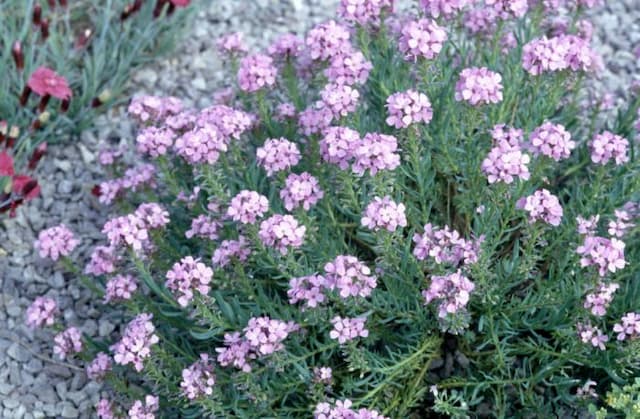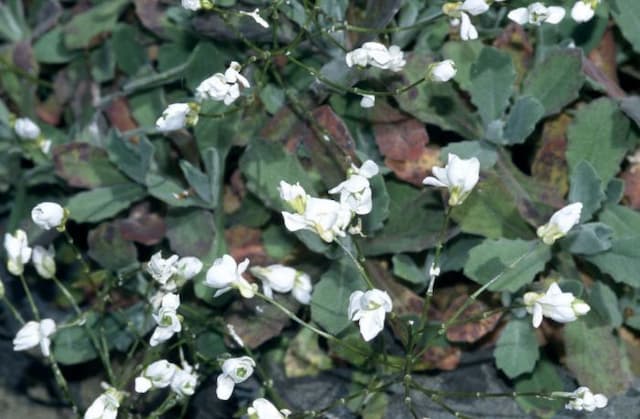Stock Matthiola incana Cinderella Series, mixed

ABOUT
The Matthiola incana Cinderella Series, commonly known as Stock or Garden Stock, is adorned with a delightful range of colors, making it an attractive addition to any garden space. These plants typically produce clusters of full, double flowers that can be found in shades such as white, pink, lilac, and deep purple, often graced with a lovely, sweet fragrance that is most pronounced in the evening. The blossoms of Stock are densely packed along spikes that rise elegantly above the foliage, creating a vibrant and textured visual display. The leaves are grayish-green and lance-shaped, providing a pleasant backdrop to the richly colored flowers and enhancing their appeal. The overall form of the plant is bushy and compact, which contributes to its neat and tidy appearance in a garden setting. Stock flowers from the Cinderella Series are excellent for cutting, offering a long vase life, which makes them a perfect choice for floral arrangements or bouquets. With their splendid colors and delightful scent, these plants are sure to be a focal point wherever they are grown.
About this plant
 Names
NamesFamily
Brassicaceae
Synonyms
Stock, Hoary Stock, Gillyflower, Tenweeks Stock, Evening-scented Stock, Brompton Stock
Common names
Matthiola incana, Cheiranthus incanus, Matthiola longipetala.
 Toxicity
ToxicityTo humans
Stock is generally considered non-toxic to humans. There are no significant reports of poisoning or toxic effects from ingesting or handling this plant.
To pets
Stock is also not known to be toxic to pets. Ingesting substantial quantities might cause mild gastrointestinal upset, but there is no significant toxic risk associated with this plant for animals commonly kept as pets.
 Characteristics
CharacteristicsLife cycle
Biennials
Foliage type
Deciduous
Color of leaves
Grey-green
Flower color
Mixed
Height
1 foot [30 cm]
Spread
1 foot [30 cm]
Plant type
Herb
Hardiness zones
7
Native area
Mediterranean
Benefits
 General Benefits
General Benefits- Ornamental Value: Matthiola incana Cinderella Series adds vibrant color and visual interest to gardens with its vivid and diverse flower hues.
- Fragrance: The plant is well-known for its sweet and pleasant scent that can enhance the sensory experience of a garden or space.
- Attracts Pollinators: It serves as a magnet for pollinators such as bees and butterflies, thus promoting biodiversity in the garden.
- Easy to Grow: Cinderella Stock is considered easy to cultivate, making it suitable for gardeners of all skill levels.
- Compact Growth: Its compact growth habit makes it ideal for borders, bedding, and container gardening.
- Cut Flower Use: The stems and blooms are popular for use in cut flower arrangements due to their beauty and fragrance.
- Cold Tolerant: Matthiola incana is tolerant of cooler temperatures, making it a good choice for early spring and autumn plantings.
- Long Blooming Period: It offers a relatively long flowering season, providing color and interest over an extended period.
- Variety of Colors: The Cinderella Series comes in a range of colors, giving gardeners the flexibility to design their space according to color schemes.
- Space Efficient: Due to their compact size, they are ideal for gardens where space is at a premium.
 Medical Properties
Medical PropertiesThis plant is not used for medical purposes.
 Air-purifying Qualities
Air-purifying QualitiesThis plant is not specifically known for air purifying qualities.
 Other Uses
Other Uses- As a natural dye: The petals of stock flowers can be used to create natural dyes for coloring fabrics, yarns, or papers in shades of purple, pink, and white, representing the typical range of colors found in the Matthiola incana Cinderella Series.
- Educational tool: The diverse color range and growth habit of stock flowers are excellent for teaching students about plant genetics and hybridization in both formal and informal educational settings.
- Fragrance extraction: Stocks have a strong, spicy-sweet fragrance that can be extracted for use in homemade perfumes, sachets, and scented candles.
- Flower pressing: The vibrant colors and relatively flat shape of Matthiola incana petals make them suitable for flower pressing, an activity used to create decorative art pieces or to embellish stationary and bookmarks.
- Photography subject: Stock flowers, with their bright colors and dense inflorescences, are ideal subjects for flower photography, helping both amateur and professional photographers to develop their macro photography skills.
- Companion planting: Stock flowers are used in companion planting to attract pollinators like bees, butterflies, and birds, which in turn help to pollinate vegetable and fruit gardens.
- Culinary decoration: While not widely known for culinary use, the flowers of Matthiola incana can be used as edible decorations on cakes and desserts, assuming no pesticides have been used.
- Floral crafts: The stems and flowers of Matthiola incana can be incorporated into homemade wreaths, garlands, and other floral crafts due to their robustness and variety of colors.
- Creative writing inspiration: The various hues and sweet scent of stock flowers serve as a sensory stimulus that can inspire poets and writers in their creative endeavors.
- Language of flowers: In the Victorian language of flowers, also known as floriography, Matthiola incana can be used to symbolize lasting beauty and a happy life, often included in bouquets to convey these messages.
Interesting Facts
 Feng Shui
Feng ShuiThe Stock is not used in Feng Shui practice.
 Zodiac Sign Compitability
Zodiac Sign CompitabilityThe Stock is not used in astrology practice.
 Plant Symbolism
Plant Symbolism- Beauty - Matthiola incana, commonly known as stock, often symbolizes beauty due to its richly colored and aromatic blossoms, representing an appreciation of sensory pleasures.
- Lasting Affection - The stock flower is also associated with lasting affection, as it has a long vase life when cut, and is associated with bonds that endure over time.
- Happy Life - Due to its pleasant fragrance and delightful appearance, stock is often used in bouquets and floral arrangements to convey wishes of a happy life, suggesting contentment and joy.
- Bond of Love - The strong and pleasant scent of stock flowers is thought to reflect the depth and endurance of love, making it a common choice for romantic occasions.
- Promptness - In the language of flowers, stock can also represent promptness, possibly because the flower blooms quickly from seed or perhaps as a reminder to act swiftly in showing affection.
 Water
WaterStock (Matthiola incana Cinderella Series) should be watered deeply when the top inch of soil feels dry to the touch. It's usually sufficient to water once or twice a week, depending on climate conditions and the size of the plant. During particularly hot or dry weather, water consumption may increase, and the plant may need additional watering. It is best to avoid overhead watering to prevent disease, focusing instead on ground level or drip irrigation. On average, aim for about 1 gallon of water per plant each week, adjusting as necessary based on weather and soil moisture levels.
 Light
LightStock (Matthiola incana Cinderella Series) thrives in full sun to partial shade. The ideal spot is where the plant receives at least 6 hours of direct sunlight a day. However, in extremely hot climates, some afternoon shade can be beneficial to protect the plant from intense heat.
 Temperature
TemperatureStock (Matthiola incana Cinderella Series) prefers cool to moderate temperatures, thriving in a range between 50 to 65 degrees Fahrenheit. They can tolerate a minimum temperature of about 40 degrees Fahrenheit and a maximum of about 70 degrees Fahrenheit. They perform best with cool nights and mild daytime temperatures.
 Pruning
PruningStock (Matthiola incana Cinderella Series) should be pruned to remove spent flowers, which encourages further blooming. This deadheading can be done throughout the blooming season as flowers fade. In addition, light pruning can help maintain shape and encourage bushier growth. The best time for heavy pruning is in the late winter or early spring, just before new growth begins.
 Cleaning
CleaningAs needed
 Soil
SoilStock flowers (Matthiola incana Cinderella Series) thrive in a well-draining soil mix with compost or peat moss, vermiculite, and perlite. A neutral to slightly alkaline pH between 7.0 and 7.5 is ideal for these plants. To nourish the stocks, incorporate balanced, slow-release fertilizer into the soil mix.
 Repotting
RepottingStock flowers, generally grown as annuals, do not often require repotting. If grown as perennials, they may be repotted every couple of years to replenish soil nutrients. Ensure adequate root space to prevent overcrowding.
 Humidity & Misting
Humidity & MistingStock flowers prefer moderate humidity levels. While they can tolerate some humidity variation, they thrive best in an environment that is not overly humid to prevent issues such as mildew.
 Suitable locations
Suitable locationsIndoor
Place in bright, indirect light and maintain cool temperatures for indoor growth.
Outdoor
Plant in full sun to partial shade and protect from strong winds outdoors.
Hardiness zone
7-10 USDA
 Life cycle
Life cycleThe Matthiola incana Cinderella Series, commonly known as Stock flower, begins its life cycle when the seeds are sown in fertile, well-draining soil, usually in early spring or late winter under cover for an early start. The seeds germinate within a week or two at temperatures between 55-65°F, and seedlings start to emerge. As the seedlings grow, they develop true leaves and are eventually transplanted to their final growing location when the risk of frost has passed. The plant goes through a vegetative growth stage where the foliage becomes lush and full. Following vegetative growth, Stocks enter the blooming stage, where spikes of fragrant flowers in various colors blossom typically in late spring or early summer. After flowering, the plants set seed and eventually complete their cycle by senescence at the end of the growing season, especially if they are not perennial in the planting zone.
 Propogation
PropogationPropogation time
Spring to Summer
Stock, particularly the Matthiola incana Cinderella Series, is typically propagated by seed. The most popular method to propagate Stock is to sow seeds directly into the soil or in a seed-starting tray. This should ideally be done in the spring after the last frost for outdoor planting, or 6 to 8 weeks before the last expected frost if starting indoors to get a head start on the season. The seeds should be sprinkled on the surface of the soil and then lightly covered with about 1/8 inch (approximately 3 millimeters) of soil. Seedlings generally sprout within a week to ten days if kept at room temperature. It is crucial to keep the soil moist but not soggy to encourage germination and initial growth. After the seedlings have developed their first set of true leaves, they can be thinned out or transplanted to give each plant enough space to grow.






![Aubrieta [Axcent Burgundy]](/_next/image?url=https%3A%2F%2Fplants-admin.emdemapps.com%2Fimages%2Fplants%2F%2Fimages%2F604b5b7b548d8.png&w=640&q=75)


